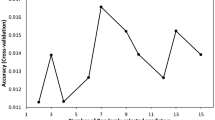Abstract
The classification methodology based on morphometric data and supervised artificial neural networks (ANN) was tested on five fly species of the parasitoid genera Tachina and Ectophasia (Diptera, Tachinidae). Objects were initially photographed, then digitalized; consequently the picture was scaled and measured by means of an image analyser. The 16 variables used for classification included length of different wing veins or their parts and width of antennal segments. The sex was found to have some influence on the data and was included in the study as another input variable. Better and reliable classification was obtained when data from both the right and left wings were entered, the data from one wing were however found to be sufficient. The prediction success (correct identification of unknown test samples) varied from 88 to 100% throughout the study depending especially on the number of specimens in the training set. Classification of the studied Diptera species using ANN is possible assuming a sufficiently high number (tens) of specimens of each species is available for the ANN training. The methodology proposed is quite general and can be applied for all biological objects where it is possible to define adequate diagnostic characters and create the appropriate database.
Similar content being viewed by others
References
Bishop C. 1995. Neural Networks for Pattern Recognition. Oxford University Press, 504 pp.
Carling A. 1992. Introducing Neural Networks. Sigma Press, Wilmslow, UK, 338 pp.
Clark J.Y. 2003. Artificial neural networks for species identification by taxonomists. BioSystems 72: 131–147.
Chesmore D. 2004. Automated bioacoustic identification of species. An. Acad. Bras. Cienc. 76: 435–440.
Do M.T., Harp J.M. & Norris K.C. 1999. A test of a pattern recognition system for identification of spiders. Bull. Entomol. Res. 89: 217–224.
Fausett L. 1994. Fundamentals of Neural Networks: Architectures, Algorithms and Applications. Prentice Hall, New York, 461 pp.
Gaston K.J. & O’Neill M.A. 2004. Automated species identification: why not? Philos. Trans. R. Soc. Lond. B Biol. Sci. 359: 655–667.
Hennig W. 1954. Flügelgeäder und System der Dipteren unter Berücksichtigung der aus dem Mesosoikum beschriebenen Fossilien. Beitr. Entomol. 4: 245–388.
Hernández-Borges J., Corbella-Tena R., Rodriguez-Delgado M.A., Garcia-Montelongo F.J. & Havel J. 2004. Content of aliphatic hydrocarbons in limpets as a new way for classification of species using Artificial Neural Networks. Chemosphere 54: 1059–1069.
Houle D., Mezey J., Galpern P. & Carter A. 2003. Automated measurement of Drosophila wings. BMC Evolutionary Biology 3: 25. doi:10.1186/1471-2148-3-25. http://www.biomedcentral.com/1471-2148/3/25 (accessed 12.10.2006).
Kukalová-Peck J. 1991. Fossil history and the evolution of hexapod structures, pp. 141–179. In: Naumann I.D. (ed.), The Insects of Australia, Vol. 1, Melbourne Univ. Press.
McAlpine J.F. 1989. Phylogeny and classification of the Muscomorpha, pp. 1397–1505. In: McAlpine J.F. (ed.), Manual of Nearctic Diptera, Vol. 3, Monograph No. 32, Research Branch, Agriculture Canada, Ottawa.
Marcondes C.B. & Borges P.S. 2000. Distinction of males of the Lutzomyia intermedia (Lutz & Neiva, 1912) species complex by ratios between dimensions and by an Artificial Neural Network (Diptera: Psychodidae, Phlebotominae). Mem. Inst. Oswaldo Cruz 95: 685–688.
Patterson D. 1996. Artificial Neural Networks: Theory and Applications. Prentice Hall, Singapore.
Tofilski A. 2004. DrawWing, a program for numerical description of insect wings. J. Insect Sci. 4: 17. http://www.pubmedcentral.nih.gov/picrender.fcgi?artid=528877&blobtype=pdf (accessed 12.10.2006).
Tóthová A., Bryja J., Bejdák P. & Vaňhara J. 2006. Molecular markers used in phylogenetic studies of Diptera with a methodological overview. Dipterologica Bohemoslovaca, Vol. 13, Acta Univ. Carol. Biol. 50: 125–133.
Tschorsnig H.-P. & Herting B. 1994. Die Raupenfliegen (Diptera: Tachinidae) Mitteleuropas: Bestimmungstabelles und Angaben zur Verbreitung und Ökologie der einzelnen Arten. Stuttgarter Beiträge zur Naturkunde, Serie A, No. 506, pp. 1–170. Online authorized version of English translation by Rayner R. & Raper C. “Tschorsnig H.-P. & Herting B. 2001. The Tachinids (Diptera: Tachinidae) of Central Europe: Identification keys for the species and data on distribution and ecology“. http://tachinidae.org.uk/site/downloads.php (accessed 12.10.2006).
Tschorsnig H.-P. & Richter V. 1998. Tachinidae, pp. 691–827. In: Papp L. & Darvas B. (eds), Contributions to a Manual of Palaearctic Diptera (with special reference to flies of economic importance), Vol. 3., Higher Brachycera, Science Herald, Budapest.
Tschorsnig H.-P., Richter V.A., Cerretti P., Zeegers T., Bergström C., Vaňhara J., Van de Weyer G., Bystrowski C., Raper C., Ziegler J. & Hubenov, Z. 2005. Tachinidae. In: Fauna Europaea Service, Version 1.2. http://www.faunaeur.org (accessed 12.10.2006).
Vaňhara J., Tschorsnig H.-P. & Barták M. 2004. New records of Tachinidae (Diptera) from the Czech Republic and Slovakia, with revised check-list. Stud. Dipterol. 10 (2003): 679–701.
Weeks P.J.D. & Gaston K.J. 1997. Image analysis, neural networks, and the taxonomic impediment to biodiversity studies. Biodivers. Conserv. 6: 263–274.
Weeks P.J.D., Gauld I.D., Gaston K.J. & O’Neill M.A. 1997. Automating the identification of insects: a new solution to an old problem. Bull. Entomol. Res. 87: 203–211.
Zupan J. & Gasteiger J. 1999. Neural Networks in Chemistry and Drug Design. Wiley-VCH, Weinheim, 380 pp.
Author information
Authors and Affiliations
Corresponding authors
Rights and permissions
About this article
Cite this article
Vaňhara, J., Muráriková, N., Malenovský, I. et al. Artificial neural networks for fly identification: A case study from the genera Tachina and Ectophasia (Diptera, Tachinidae). Biologia 62, 462–469 (2007). https://doi.org/10.2478/s11756-007-0089-1
Received:
Accepted:
Issue Date:
DOI: https://doi.org/10.2478/s11756-007-0089-1




